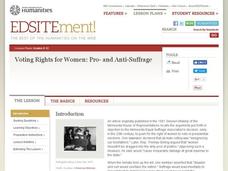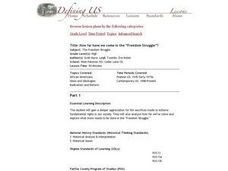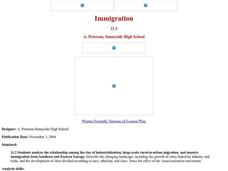Curated OER
Voting Rights for Women: Pro- and Anti-Suffrage
Students examine the arguments for and against suffrage for women in the 19th and early 20th centuries. They explore various websites, read and discuss primary source documents, develop a document from two points of view, and analyze...
Curated OER
United States-Japanese Relations in Post World War II Era
Ninth graders analyze political cartoons and posters relating to the United States and Japan in the period following World War II. They discuss the positive and negative consequences of the United States occupation of Japan.
Curated OER
How far have we come in the "Freedom Struggle"?
Eleventh graders assess an appreciation for the sacrifices made to achieve fundamental rights in our society. They analyze how far we've come to explore what more needs to be done in the "Freedom Struggle." Each student completes a...
Curated OER
The Union is Perpetual: Lincoln is Elected
Students take a closer look at the election of Abraham Lincoln. In this historical analysis lesson, students analyze letters, political cartoons, and campaign materials from Lincoln's campaign. Analysis worksheets are included.
Curated OER
History by Heroes
Students role play one of the Presidents between 1877 and today. Individually, they use the internet to research the President through official documents, political cartoons and various editorials. Throughout the year, they are asked to...
University of Wisconsin
Why Did the Triangle Fire Occur?
An investigation of the 1911 New York City Triangle Shirtwaist Factory fire leads class members to examine primary and secondary source materials related to the event and apply what they learn about the working conditions at the time to...
Curated OER
The Pioneer Experience
Tenth graders consider the move westward. For this Westward Movement lesson, 10th graders compare and contrast the experiences of 2 pioneers by creating t-charts. Students analyze diaries, photographs, and political cartoons that capture...
Curated OER
Impact of War with Asia on Asian Americans
Eleventh graders identify perceptions towards Asians widely held by the American public through the analysis of political cartoons from the 1940's and 1990's
Curated OER
Tibet and the U.S.
Students study the Tibetan situation. In this global issues lesson, students listen to a lecture regarding Tibet, its location, and its ties to China. Students then create political cartoons or write letters to their Congressperson about...
Curated OER
The Volstead Act and Related Prohibition Documents
Students listen to the 18th Amendment. After a discussion on Prohibition, the groups determine if it was a success or a failure and present their findings to the class. They view political cartoons of the day and analyze their meaning.
Curated OER
Immigration
High schoolers explore the concept of immigration. In this immigration lesson, students read literature, analyze photographs, and evaluate political cartoons that reflect feelings about immigration in America during Industrialization....
Curated OER
Progressive Reforms
Tenth graders analyze editorial cartoons focusing on progressive reform. They compare their analysis and research. Students discuss the cost of reform leading to the creation of a national income tax through the passage of the 16th...
GCSE Modern World History
Mao's China
Here is a great textbook chapter on China's establishment as a communist state in 1949 and the effects of World War II on the nation. The first page prompts learners to complete a timeline activity as they read the material, which...
New York State Education Department
Global History and Geography Examination: January 2013
How much do high schoolers know about human history? The assessment covers global history and geography with multiple choice, document based items, and essay questions. It covers topics such as human migration patterns and religions of...
Curated OER
On the Other Side of the Color Barrier: Segregation and the Negro Leagues
Young scholars study segregation that occurred in the past and that is currently occurring. In this equal rights lesson plan, students use primary source documents to student segregation of the past. In a culminating activity, young...
Curated OER
Images of Immigration
High schoolers evaluate how images of immigrants reflected political and social attitudes toward them in the United States. They interpret visual images in the context of historical and political developments.
Center for History Education
Should the Colonists Have Revolted Against Great Britain?
Should the Americans have taken the plunge and revolted against Great Britain? Using documents, including the famed Common Sense and a Loyalist response, pupils conduct a lengthy investigation of the question. The interesting resource...
Curated OER
The Kansas and Nebraska Act
Students use a primary source of a political cartoon to set the context for a lesson. They answer key questions in writing or orally. Students conduct a class discussion about the issue to stimulate higher order thinking skills like...
Curated OER
30 Day Journal
Young scholars collect articles, political cartoons, photographs and other artifacts relating to a specific traumatic event, such as September 11th. They reflect on their artifacts in written journals.
Stanford University
Soldiers in the Philippines
Young scholars examine the Philippine War and the treatment of Filipino soldiers.In this Philippine War lesson, studnets analyze documents and inquire as to why there was such brutality. Students use graphic organizers to record their...
Curated OER
The Union is Perpetual: Lincoln is Elected
Middle schoolers view primary documents about the race for President in the time of Abraham Lincoln. For this election lesson, students prepare arguments for and against Lincoln using an analysis sheet. Middle schoolers create a poster...
Curated OER
Global Warming--Points of view
Pupils are introduced to global warming through analysis of political/editorial cartoons dealing with the subject. They discuss the cartoon and what the feel it means and then discuss the mechanics of and the concerns about global warming.
Curated OER
Declaration of Independence
Eighth graders explain the meaning of the Declaration of Independence. They view a political cartoon of the period, then do a writing assignment for homework. They write about how they would feel if the British were calling them traitors.
Utah Education Network (UEN)
8th Grade Poetry: Narrative Poem
The first lesson of a five-lesson unit designed for eighth graders has class members reading and watching a video of Edgar Allen Poe's narrative poem, "The Raven." They then craft their narrative poem, illustrate it, and share their work...

























